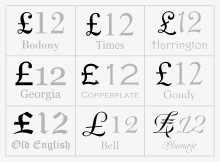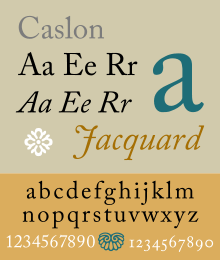Pound sign
The pound sign £ is the symbol for the pound sterling – the currency of the United Kingdom and previously of Great Britain and of the Kingdom of England. The same symbol is used for other currencies called pound, such as the Gibraltar pound, the Egyptian pound, and the Syrian pound. A similar symbol ₤ (with two bars) was used on some banknotes from time to time but the Bank of England has not done so since 1975. (This two-bar symbol is also used for currencies named lira, for example the (withdrawn) Italian lira).
| £ | |
|---|---|
Pound sign | |
| In Unicode | U+00A3 £ POUND SIGN (HTML £ · £) |
| Currency | |
| Currency | Pound sterling |
| Different from | |
| Different from | U+20A4 ₤ LIRA SIGN U+0023 # NUMBER SIGN |
For some people in the US, "pound sign" refers to the symbol # (number sign).
Origin
The symbol derives from the upper case Latin letter L, representing libra pondo, the basic unit of weight in the Roman Empire, which in turn is derived from the Latin word, libra, meaning scales or a balance. The pound became an English unit of weight and in England became defined as the tower pound (equivalent to 350 grams) of sterling silver.[1][2] According to the Royal Mint Museum:
It is not known for certain when the horizontal line or lines, which indicate an abbreviation, first came to be drawn through the L. However, there is in the Bank of England Museum a cheque dated 7 January 1661 with a clearly discernible £ sign. By the time the Bank was founded in 1694 the £ sign was in common use.[3]
However, the simple letter L, in lower- or uppercase, was used to represent the pound sterling in printed books and newspapers until well into the 19th century.[4] In the blackletter type used until the seventeenth century,[5] the letter L is rendered as .
Usage
The pound sign is placed before the number (e.g. "£12,000") and separated from the following digits by no space or only a thin space.
Other English variants
Canadian English
In Canadian English the symbols £ and # are both called the pound sign, but the # is also known as the 'number sign' and as the 'noughts-and-crosses board'.[lower-alpha 1][6]
US English
In American English, the term "pound sign" usually refers to the symbol # (number sign), and the corresponding telephone key is called the "pound key".[7]
Historic variants
Double dash style
Banknotes issued by the Bank of England since 1975 have only used the single bar style as a pound sign.[8][9] The Bank used both the two-bar style (₤) and the one-bar style (£) (and sometimes a figure without any symbol whatever) more or less equally since 1725 until 1971, intermittently and sometimes concurrently.[8] In typography, the symbols are allographs – style choices – when used to represent the pound and both use the same POUND SIGN Unicode code point, (not LIRA SIGN despite its looking the same).
Currencies that use the pound sign
- United Kingdom: Pound sterling
- Egypt: Egyptian pound
- Gibraltar: Gibraltar pound
- Syria: Syrian pound
- South Sudan: South Sudanese pound
Code points
In the Unicode standard, the symbol £ is called POUND SIGN and the symbol ₤ is the LIRA SIGN. These have respective code points:
- U+00A3 £ POUND SIGN (HTML
£·£· inherited from Latin-1)[11] - U+20A4 ₤ LIRA SIGN (HTML
₤)[12]
Unicode notes that the "lira sign" is not widely used and was added due to both it and the pound sign being available on HP printers, and also states that the preferred sign for lira is the pound sign.[13]
The encoding of the £ symbol in position xA3 was first standardised by ISO Latin-1 in 1985. Position xA3 was used by the Digital Equipment Corporation VT220 terminal, Mac OS Roman, the Amstrad CPC, the Commodore Amiga and the Acorn Archimedes.
Many early computers (limited to a 7-bit, 128-position character set) used a variant of ASCII with one of the less-frequently used characters replaced by the £. The UK national variant of ISO 646 was standardised as BS 4730 in 1985. This code was identical to ASCII except for two characters: x23 encoded £ instead of #, while x7E encoded ‾ instead of ~. MSDOS on the IBM PC originally used a non-standard 8-bit character set Code page 437 in which the £ symbol was encoded as x9C; adoption of ISO character codes only came later with Microsoft Windows. The Atari ST also used position x9C. The HP Laserjet used position xBA for the £ symbol, while most other printers used x9C. The BBC Ceefax system which dated from 1976 encoded the £ as x23. The ZX Spectrum and the BBC Micro used x60 ` (grave). The Commodore 64 used x5C \ while the Oric used x5F _. IBM's EBCDIC code page 037 uses xB1 for the £ while its code page 285 uses x5B. ICL's 1900-series mainframes used a six-bit (64-position character set) encoding for characters, loosely based on BS 4730, with the £ symbol represented as octal 23 (hex 13, dec 19).
Entry methods
Typewriters
Typewriters produced for the British market included a "£" sign from the earliest days, though its position varied widely. A 1921 advertisement for an Imperial Typewriters model D, for example[14] shows a machine with two modifier shifts (CAPS and FIG), with the "£" sign occupying the FIG shift position on the key for letter "B". But the advertisement notes that "We make special keyboards containing symbols, fractions, signs, etc., for the peculiar needs of Engineers, Builders, Architects, Chemists, Scientists, etc., or any staple trade."
On Latin-alphabet typewriters lacking a "£" symbol type element, a reasonable approximation could be made by typing an "f" over an "L".
Windows, Linux, Unix
On Microsoft Windows, Linux and Unix, the UK keyboard layout has the "£" symbol on the 3 number key and is typed using:
- ⇧ Shift+3
On a US-International keyboard in Windows,[16] the "£" can be entered using:
- ⇧ Shift+AltGr+4
- ⇧ Shift+Ctrl+Alt+4 (on older keyboards without an AltGr key)
On a US-International keyboard in Linux and Unix, the "£" can be entered using:
- Ctrl+⇧ Shift+U followed by a 3
- ⇧ Shift+AltGr+3
In Windows, it can also be generated through the Alt keycodes, although the results vary depending on factors such as the locale, codepage and OS version:
- Alt+0163 (keeping Alt pressed until all 4 digits have been typed on the numeric keypad only)
- Alt+156 (this also works in MS-DOS)
The Character Map utility and Microsoft Word's Insert Symbol commands may also be used to enter this character.[lower-alpha 2]
MacOS
The symbol "£" is in the MacRoman character set and can be generated on most non-UK Mac OS keyboard layouts which do not have a dedicated key for it, typically through:
- ⌥ Option+3
On UK Apple Mac keyboards, this is reversed, with the "£" symbol on the number 3 key, typed using:
- ⇧ Shift+3 (and the number sign "#" generated by ⌥ Option+3)
Android
Press and hold the local currency sign ($ for US/Canada users, € sign for EU users, etc): a popup box presenting an array of currency signs is presented from which the £ may be chosen.[17]
Other uses
The logo of the UK Independence Party, a British political party, is based on the pound sign,[18] symbolising the party's opposition to adoption of the euro and to the European Union generally.
A symbol that appears to be a double-barred pound sign is used as the logo of the British record label Parlophone. In fact this is a stylised version of a blackletter L (), standing for Lindström (the firm's founder Carl Lindström).
The pound sign was used as an uppercase letter (the lowercase being ſ) signifying [ʒ] in the early 1993–1995 version of the Turkmen Latin alphabet.[19]
See also
- Latin letter L with stroke Ł ł
- Category:Currency symbols
- Semuncia 𐆒
Notes
- "Noughts-and-crosses" is another name for the game called "Tic-tac-toe" in American English.
- Be careful not to choose the similar ₤ as this will produce a lira sign, which has a different code point.
References
- Thomas Snelling (1762). A View of the Silver Coin and Coinage of England from the Norman Conquest to the Present Time:. T. Snelling. p. ii. Retrieved 19 September 2016.
- "A brief history of the pound". The Dozenal Society of Great Britain. Retrieved 2011-01-14.
- "The Origins of £sd". The Royal Mint Museum. Retrieved 2019-04-30.
- For example, Samuel Pepys (2 January 1660). "Diary of Samuel Pepys/1660/January". Retrieved 23 September 2019. Then I went to Mr. Crew's and borrowed L10 of Mr. Andrewes for my own use, and so went to my office, where there was nothing to do.
- Dowding, Geoffrey (1962). An introduction to the history of printing types; an illustrated summary of main stages in the development of type design from 1440 up to the present day: an aid to type face identification. Clerkenwell [London]: Wace. p. 5.
- Barber, Katherine, ed. (2004). The Canadian Oxford dictionary (2nd ed.). Toronto: Oxford University Press. ISBN 0-19-541816-6.
- William Safire (1991-03-24). "On Language; Hit the Pound Sign". New York Times. Retrieved 2011-05-21.
- "Withdrawn banknotes". Bank of England. Retrieved 13 September 2019. ("£1 1st Series Treasury Issue" to "£5 Series B")
- "Current banknotes". Bank of England. Retrieved 8 November 2019.
- Howes, Justin (2000). "Caslon's punches and matrices". Matrix. 20: 1–7.
- The Unicode Consortium (11 June 2015). "The Unicode Standard, Version 10.0 | Character Code Charts" (PDF). Retrieved 2018-01-23.
- The Unicode Consortium (26 August 2015). "The Unicode Standard, Version 10.0 | Character Code Charts" (PDF). Retrieved 2018-01-23.
- Allen, Julie D., ed. (August 2015) [1991]. "The Unicode Standard - Version 8.0 - Core Specification - Chapter 22.1. Currency Symbols" (PDF). Mountain View, CA, USA: Unicode, Inc. pp. 751–752. ISBN 978-1-936213-10-8. Archived (PDF) from the original on 2016-12-06. Retrieved 2016-12-06.
[…] Currency Symbols: U+20A0–U+20CF […] Lira Sign. A separate currency sign U+20A4 LIRA SIGN is encoded for compatibility with the HP Roman-8 character set, which is still widely implemented in printers. In general, U+00A3 POUND SIGN may be used for both the various currencies known as pound (or punt) and the currencies known as lira. […]
- "Imperial Typewriter Co". www.gracesguide.co.uk.
- "Compose Key cheat sheet". GitHub. Retrieved 12 November 2019. (Caution: the 'additional' method suggested, Compose/l/=, should produce a lira sign U+20A4 rather than a pound sign).
- "Using the US International Keyboard Layout" (PDF). College of Saint Benedict and Saint John's University. Retrieved 14 November 2019.
- J. D. Biersdorfer (7 January 2016). "TECH TIP: How to Add Currency Symbols to Text in Android". New York Times. Retrieved 12 November 2019.
- "UKIP". Retrieved 17 April 2017.
- Clement, Victoria. 2008. Emblems of independence: script choice in post-Soviet Turkmenistan in the 1990s. International Journal of the Sociology of Language 192: 171-185

